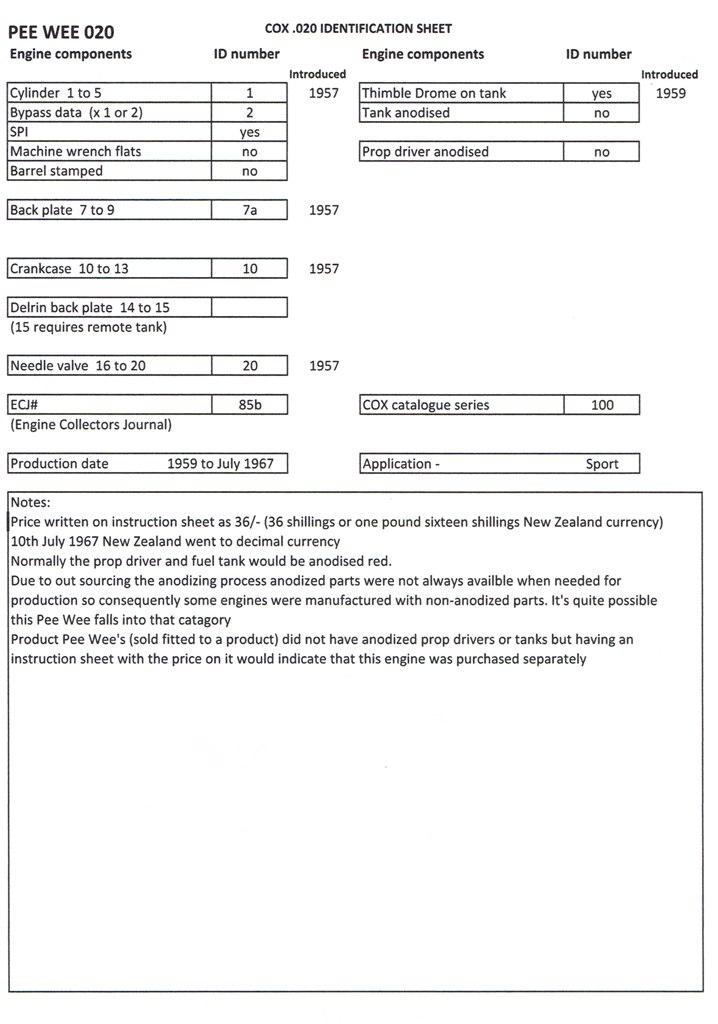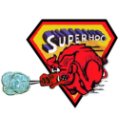Log in
Search
Latest topics
» Free Flight Radio Assist by GallopingGhostler Today at 12:54 pm
» My N-1R build log
by akjgardner Today at 12:39 pm
» Purchased the last of any bult engines from Ken Enya
by getback Today at 12:05 pm
» Funny what you find when you go looking
by rsv1cox Yesterday at 3:21 pm
» Landing-gear tips
by 1975 control line guy Yesterday at 8:17 am
» Cox NaBOO - Just in time for Halloween
by rsv1cox Tue Nov 19, 2024 6:35 pm
» Canada Post strike - We are still shipping :)
by Cox International Tue Nov 19, 2024 12:01 pm
» Duende V model from RC Model magazine 1983.
by getback Tue Nov 19, 2024 6:08 am
» My current avatar photo
by roddie Mon Nov 18, 2024 9:05 pm
» My latest doodle...
by TD ABUSER Mon Nov 18, 2024 11:30 am
» Brushless motors?
by rsv1cox Sun Nov 17, 2024 6:40 pm
» Tribute Shoestring build
by amurphy6812 Sun Nov 17, 2024 5:43 pm
Cox Engine of The Month
Baby Bee and Pee Wee 020
Page 1 of 1
 Baby Bee and Pee Wee 020
Baby Bee and Pee Wee 020
I got this lot locally for NZ$54 (US$34) which I think was a pretty good deal. The Baby Bee and the Pee Wee 20 are both still new and unused and were bought by the seller’s father. They both have the price written on their relative instructions in shillings (Bee 35/- and Pee Wee 36/-) which dates them as pre 7th July 1967 which is when New Zealand went decimal. The seller has cut the bubble pack open as he had thought about using the Bee.

When I picked the stuff up he gave me the beaten up Cox engine. It has had the backplate cut on the sides, the needle has been shortened, the prop driver has had the side cut out of it and he said he had used a dremel inside the prop driver. Why I don’t know but the result is the end of the crank has been half gnawed away. The head, although the filament works, looks as though it’s been used to bang tent pegs in. The only things salvageable are the barrel, rod and piston, which has a small groove cut around the base of the skirt. The crankcase has vice jaw marks on it but looks serviceable and will clean up I think. Why this poor engine was singled out for such treatment is hard to comprehend.
Maybe someone on the forum can tell me what years that black bubble packet was used which will help nail down the year of the Bee. Using the Cox Model engine handbook it looks like both engines have the earliest style of metal backplate and the Pee Wee seems to date from 1959 to 1967 and the Bee from late 1958 to late 1960. I made up a couple of identification sheets (020 and 049) on which I write the type of the engine components as listed in the book then look through the book until I find a match. It’s much harder when engine parts have been swapped or changed and I realise many reference books can have errors, misprints etc but with my limited (very) knowledge of Cox engines it certainly is a big help for me in trying to identify engine models or which bits don’t seem to belong.



When I picked the stuff up he gave me the beaten up Cox engine. It has had the backplate cut on the sides, the needle has been shortened, the prop driver has had the side cut out of it and he said he had used a dremel inside the prop driver. Why I don’t know but the result is the end of the crank has been half gnawed away. The head, although the filament works, looks as though it’s been used to bang tent pegs in. The only things salvageable are the barrel, rod and piston, which has a small groove cut around the base of the skirt. The crankcase has vice jaw marks on it but looks serviceable and will clean up I think. Why this poor engine was singled out for such treatment is hard to comprehend.
Maybe someone on the forum can tell me what years that black bubble packet was used which will help nail down the year of the Bee. Using the Cox Model engine handbook it looks like both engines have the earliest style of metal backplate and the Pee Wee seems to date from 1959 to 1967 and the Bee from late 1958 to late 1960. I made up a couple of identification sheets (020 and 049) on which I write the type of the engine components as listed in the book then look through the book until I find a match. It’s much harder when engine parts have been swapped or changed and I realise many reference books can have errors, misprints etc but with my limited (very) knowledge of Cox engines it certainly is a big help for me in trying to identify engine models or which bits don’t seem to belong.


Last edited by Davenz13 on Tue Sep 22, 2015 5:16 pm; edited 1 time in total

Davenz13- Platinum Member

- Posts : 597
Join date : 2013-11-28
Age : 69
Location : Palmerston North, New Zealand
 Re: Baby Bee and Pee Wee 020
Re: Baby Bee and Pee Wee 020
.
Last edited by Mudhen on Mon Nov 15, 2021 11:34 am; edited 1 time in total

Mudhen- Gold Member

- Posts : 489
Join date : 2011-09-19
 Re: Baby Bee and Pee Wee 020
Re: Baby Bee and Pee Wee 020
Thanks Mud
It does not have an intake screen so 1959

It does not have an intake screen so 1959


Davenz13- Platinum Member

- Posts : 597
Join date : 2013-11-28
Age : 69
Location : Palmerston North, New Zealand
 Re: Baby Bee and Pee Wee 020
Re: Baby Bee and Pee Wee 020
Its the same age as me but in much better shape , Good find

akjgardner- Diamond Member



Posts : 1601
Join date : 2014-12-28
Age : 65
Location : Greensberg Indiana
 Similar topics
Similar topics» Cox .020 Engines
» PZL 62 + Baby Bee
» Need some Baby Bee ID help
» cox baby bee
» The first Baby Bee??
» PZL 62 + Baby Bee
» Need some Baby Bee ID help
» cox baby bee
» The first Baby Bee??
Page 1 of 1
Permissions in this forum:
You cannot reply to topics in this forum

 Rules
Rules






